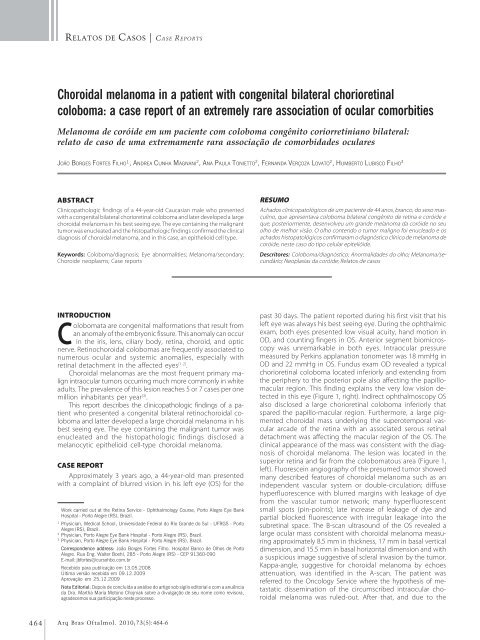Monovision and cataract surgery Visual field and OCT correlation ...
Monovision and cataract surgery Visual field and OCT correlation ...
Monovision and cataract surgery Visual field and OCT correlation ...
You also want an ePaper? Increase the reach of your titles
YUMPU automatically turns print PDFs into web optimized ePapers that Google loves.
RELATOS DE CASOS | CASE REPORTS<br />
Choroidal melanoma in a patient with congenital bilateral chorioretinal<br />
coloboma: a case report of an extremely rare association of ocular comorbities<br />
Melanoma de coróide em um paciente com coloboma congênito coriorretiniano bilateral:<br />
relato de caso de uma extremamente rara associação de comorbidades oculares<br />
JOÃO BORGES FORTES FILHO¹, ANDREA CUNHA MAGNANI 2 , ANA PAULA TONIETTO 2 , FERNANDA VERÇOZA LOVATO 2 , HUMBERTO LUBISCO FILHO 3<br />
ABSTRACT<br />
Clinicopathologic findings of a 44-year-old Caucasian male who presented<br />
with a congenital bilateral chorioretinal coloboma <strong>and</strong> later developed a large<br />
choroidal melanoma in his best seeing eye. The eye containing the malignant<br />
tumor was enucleated <strong>and</strong> the histopathologic findings confirmed the clinical<br />
diagnosis of choroidal melanoma, <strong>and</strong> in this case, an epithelioid cell type.<br />
Keywords: Coloboma/diagnosis; Eye abnormalities; Melanoma/secondary;<br />
Choroide neoplasms; Case reports<br />
RESUMO<br />
Achados clinicopatológicos de um paciente de 44 anos, branco, do sexo masculino,<br />
que apresentava coloboma bilateral congênito de retina e coróide e<br />
que, posteriormente, desenvolveu um gr<strong>and</strong>e melanoma da coróide no seu<br />
olho de melhor visão. O olho contendo o tumor maligno foi enucleado e os<br />
achados histopatológicos confirmaram o diagnóstico clínico de melanoma de<br />
coróide, neste caso do tipo celular epitelióide.<br />
Descritores: Coloboma/diagnóstico; Anormalidades do olho; Melanoma/secundário;<br />
Neoplasias da coróide; Relatos de casos<br />
INTRODUCTION<br />
Colobomata are congenital malformations that result from<br />
an anomaly of the embryonic fissure. This anomaly can occur<br />
in the iris, lens, ciliary body, retina, choroid, <strong>and</strong> optic<br />
nerve. Retinochoroidal colobomas are frequently associated to<br />
numerous ocular <strong>and</strong> systemic anomalies, especially with<br />
retinal detachment in the affected eyes (1-2) .<br />
Choroidal melanomas are the most frequent primary malign<br />
intraocular tumors occurring much more commonly in white<br />
adults. The prevalence of this lesion reaches 5 or 7 cases per one<br />
million inhabitants per year (3) .<br />
This report describes the clinicopathologic findings of a patient<br />
who presented a congenital bilateral retinochoroidal coloboma<br />
<strong>and</strong> latter developed a large choroidal melanoma in his<br />
best seeing eye. The eye containing the malignant tumor was<br />
enucleated <strong>and</strong> the histopathologic findings disclosed a<br />
melanocytic epithelioid cell-type choroidal melanoma.<br />
CASE REPORT<br />
Approximately 3 years ago, a 44-year-old man presented<br />
with a complaint of blurred vision in his left eye (OS) for the<br />
Work carried out at the Retina Service - Ophthalmology Course, Porto Alegre Eye Bank<br />
Hospital - Porto Alegre (RS), Brazil.<br />
1<br />
Physician, Medical School, Universidade Federal do Rio Gr<strong>and</strong>e do Sul - UFRGS - Porto<br />
Alegre (RS), Brazil.<br />
2<br />
Physician, Porto Alegre Eye Bank Hospital - Porto Alegre (RS), Brazil.<br />
3<br />
Physician, Porto Alegre Eye Bank Hospital - Porto Alegre (RS), Brazil.<br />
Correspondence address: João Borges Fortes Filho. Hospital Banco de Olhos de Porto<br />
Alegre. Rua Eng. Walter Boehl, 285 - Porto Alegre (RS) - CEP 91360-090<br />
E-mail: jbfortes@cursohbo.com.br<br />
Recebido para publicação em 13.05.2008<br />
Última versão recebida em 09.12.2009<br />
Aprovação em 25.12.2009<br />
Nota Editorial: Depois de concluída a análise do artigo sob sigilo editorial e com a anuência<br />
da Dra. Martha Maria Motono Chojniak sobre a divulgação de seu nome como revisora,<br />
agradecemos sua participação neste processo.<br />
past 30 days. The patient reported during his first visit that his<br />
left eye was always his best seeing eye. During the ophthalmic<br />
exam, both eyes presented low visual acuity, h<strong>and</strong> motion in<br />
OD, <strong>and</strong> counting fingers in OS. Anterior segment biomicroscopy<br />
was unremarkable in both eyes. Intraocular pressure<br />
measured by Perkins applanation tonometer was 18 mmHg in<br />
OD <strong>and</strong> 22 mmHg in OS. Fundus exam OD revealed a typical<br />
chorioretinal coloboma located inferiorly <strong>and</strong> extending from<br />
the periphery to the posterior pole also affecting the papillomacular<br />
region. This finding explains the very low vision detected<br />
in this eye (Figure 1, right). Indirect ophthalmoscopy OS<br />
also disclosed a large chorioretinal coloboma inferiorly that<br />
spared the papillo-macular region. Furthermore, a large pigmented<br />
choroidal mass underlying the superotemporal vascular<br />
arcade of the retina with an associated serous retinal<br />
detachment was affecting the macular region of the OS. The<br />
clinical appearance of the mass was consistent with the diagnosis<br />
of choroidal melanoma. The lesion was located in the<br />
superior retina <strong>and</strong> far from the colobomatous area (Figure 1,<br />
left). Fluorescein angiography of the presumed tumor showed<br />
many described features of choroidal melanoma such as an<br />
independent vascular system or double-circulation; diffuse<br />
hyperfluorescence with blurred margins with leakage of dye<br />
from the vascular tumor network; many hyperfluorescent<br />
small spots (pin-points); late increase of leakage of dye <strong>and</strong><br />
partial blocked fluorescence with irregular leakage into the<br />
subretinal space. The B-scan ultrasound of the OS revealed a<br />
large ocular mass consistent with choroidal melanoma measuring<br />
approximately 8.5 mm in thickness, 17 mm in basal vertical<br />
dimension, <strong>and</strong> 15.5 mm in basal horizontal dimension <strong>and</strong> with<br />
a suspicious image suggestive of scleral invasion by the tumor.<br />
Kappa-angle, suggestive for choroidal melanoma by echoes<br />
attenuation, was identified in the A-scan. The patient was<br />
referred to the Oncology Service where the hypothesis of metastatic<br />
dissemination of the circumscribed intraocular choroidal<br />
melanoma was ruled-out. After that, <strong>and</strong> due to the<br />
464<br />
Arq Bras Oftalmol. 2010;73(5):464-6

















